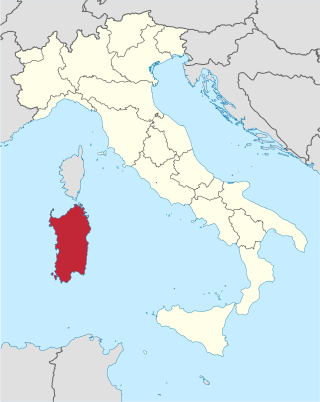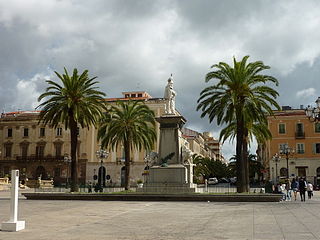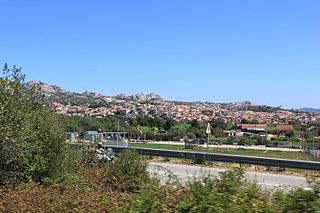
Nuoro is a city and comune (municipality) in central-eastern Sardinia, Italy, situated on the slopes of Mount Ortobene. It is the capital of the province of Nuoro. With a population of 36,347 (2011), it is the sixth-largest city in Sardinia. Its frazione (borough) of Lollove is one of I Borghi più belli d'Italia.

Sardinia is the second-largest island in the Mediterranean Sea, after Sicily, and one of the twenty regions of Italy. It is located west of the Italian Peninsula, north of Tunisia and 16.45 km south of the French island of Corsica.

Tempio Pausania is a town of about 14,000 inhabitants in the Gallura region of northern Sardinia, Italy, in the province of Sassari. It is one of I Borghi più belli d'Italia.

Olbia is a city and commune of 60,346 inhabitants in the Italian insular province of Sassari in northeastern Sardinia, Italy, in the historical region of Gallura. Called Olbia in the Roman age, Civita in the Middle Ages and the Terranova Pausania until the 1940s, Olbia has again been the official name of the city since the fascist period.

Sassari is an Italian city and the second-largest of Sardinia in terms of population with 127,525 inhabitants, and a Functional Urban Area of about 260,000 inhabitants. One of the oldest cities on the island, it contains a considerable collection of art.

Archaeological evidence of prehistoric human settlement on the island of Sardinia is present in the form of nuraghes and other prehistoric monuments, which dot the land. The recorded history of Sardinia begins with its contacts with the various people who sought to dominate western Mediterranean trade in classical antiquity: Phoenicians, Punics and Romans. Initially under the political and economic alliance with the Phoenician cities, it was partly conquered by Carthage in the late 6th century BC and then entirely by Rome after the First Punic War. The island was included for centuries in the Roman province of Sardinia and Corsica, which would be incorporated into the diocese of Italia suburbicaria in 3rd and 7th centuries.

The province of Sassari is a province in the autonomous island region of Sardinia, Italy. Its capital is the city of Sassari. As of 2017, the province had a population of 493,357 inhabitants.

Sant'Antioco is the name of both an island and a municipality (comune) in southwestern Sardinia, in the Province of South Sardinia, in Sulcis zone. With a population of 11,730, the municipality of Sant'Antioco it is the island's largest community. It is also the site of ancient Sulci, considered the second city of Sardinia in antiquity.

Arzachena is a town and comune in the province of Sassari, northern Sardinia, the second largest island off the coast of Italy. Arzachena lies halfway between the original Costa Smeralda resort and Porto Rafael, both founded in the late 1950s. After Olbia and Tempio Pausania, it is the third largest commune in Gallura by inhabitants.

Benetutti is a comune (municipality) in the Province of Sassari in the Italian region Sardinia, located about 190 kilometres (120 mi) north of Cagliari and about 91 kilometres (57 mi) southeast of Sassari.

Ittireddu is a comune (municipality) in the Province of Sassari in the Italian region Sardinia, located about 150 kilometres (93 mi) north of Cagliari and about 35 kilometres (22 mi) southeast of Sassari.

Siligo is a comune (municipality) in the region of Logudoro - Meilogu in the Province of Sassari in the Italian region Sardinia, located about 160 kilometres (99 mi) north of Cagliari and about 25 kilometres (16 mi) southeast of Sassari.

Oschiri is a comune (municipality) and former bishopric in the Province of Sassari in the Italian region Sardinia, located about 170 kilometres (110 mi) north of Cagliari and about 40 kilometres (25 mi) southwest of Olbia.
The Ozieri culture was a prehistoric pre-Nuragic culture that occupied Sardinia from c. 3200 to 2800 BCE. The Ozieri was the culmination of the island's Neolithic culture and takes its name from the locality where early findings connected with it have been found, the cave of San Michele near Ozieri, in northern Sardinia. The Ozieri existed contemporaneously with the Arzachena culture, sharing some similarities, and its influence also extended to nearby Corsica.

Sardinia is the second-largest island in the Mediterranean Sea and an autonomous region of Italy. Tourism in Sardinia is one of the fastest growing sectors of the regional economy. The island attracts more than a million tourists from both Italy, from the rest of Europe, and, to a lesser degree, from the rest of the world. According to statistics, tourist arrivals in 2016 were 2.9 million people.
The Roman Catholic Diocese of Civita(-Tempio) was a Latin Catholic bishopric in the Gallura region of northern Sardinia.

The Sardinian Romanesque is the Romanesque architectural style that developed in Sardinia. The Romanesque architecture in Sardinia has had a remarkable development since the early origins, during the Giudicati era, and for a long period. His expressions, although autonomous, are not classifiable in a recognizable image, since in the island the Romanesque manifested itself with unusual results but in numerous forms; this is due to the establishment in Sardinia of several religious orders, coming from various Italian regions and from France. Consequently, in the architectures of that era Pisan, Lombard and Provençal influences are recognizable as well as traces of the passage of workers, coming from the Iberian Peninsula, of Islamic culture. In total there are over 150 Romanesque monuments in Sardinia.

The Civic Archaeological Museum "Alle Clarisse" of Ozieri is one of the most important museums in Northern Sardinia. Since 2003 it has been transferred to the former Poor Clares' convent. Its showcases contain the most significant finds found in the municipal area of Ozieri: the materials on display date from prehistoric times to the Modern Age.
Architecture of Sardinia has developed since 4000 B.C., presenting characteristic aspects in certain historical periods, especially in the Nuragic age.























